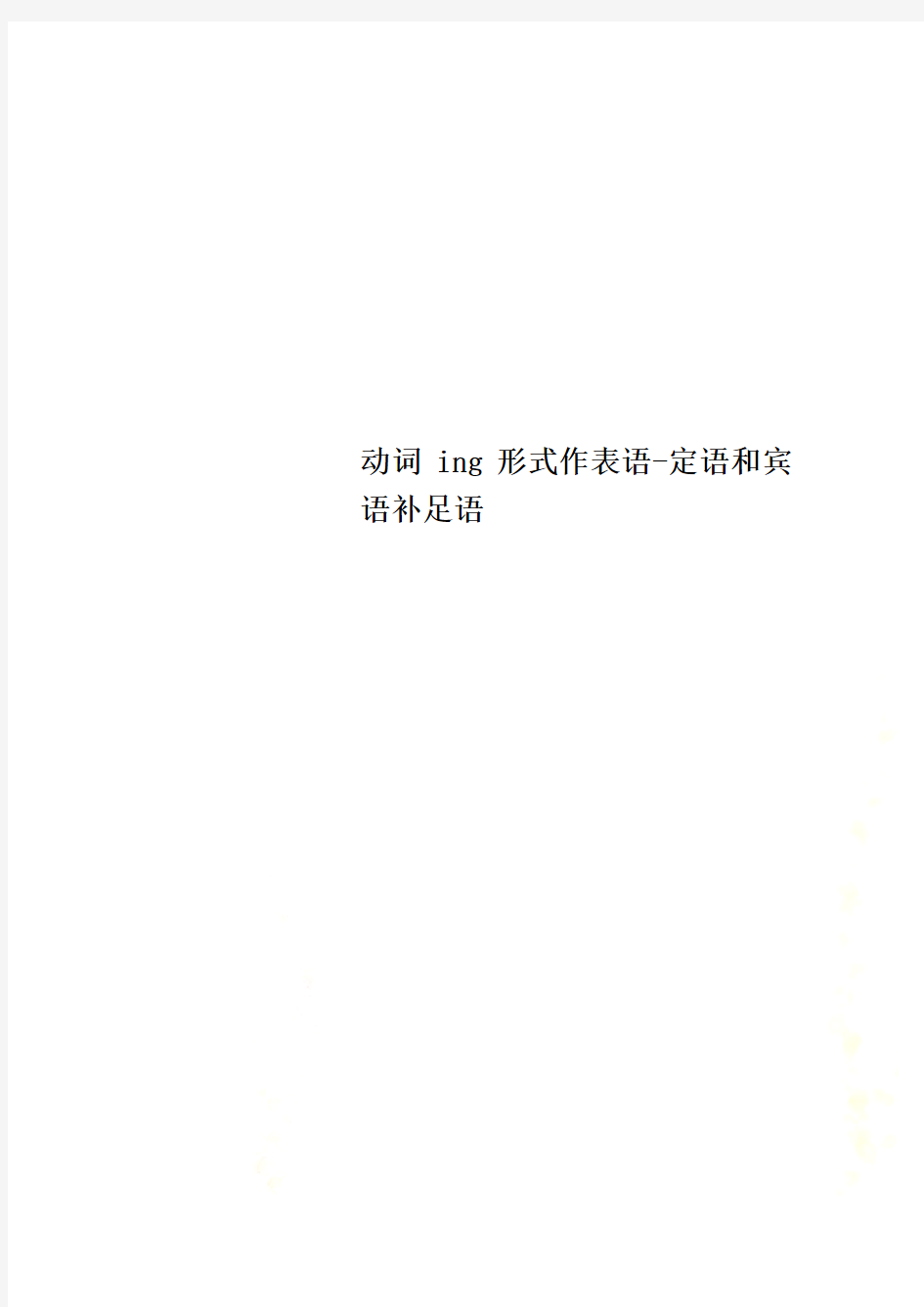动词ing形式作表语-定语和宾语补足语

- 1、下载文档前请自行甄别文档内容的完整性,平台不提供额外的编辑、内容补充、找答案等附加服务。
- 2、"仅部分预览"的文档,不可在线预览部分如存在完整性等问题,可反馈申请退款(可完整预览的文档不适用该条件!)。
- 3、如文档侵犯您的权益,请联系客服反馈,我们会尽快为您处理(人工客服工作时间:9:00-18:30)。
动词ing形式作表语-定语和宾语补足语
概念引入
The music they are playing sounds so exciting .
We watched three boys sharing their food with each
Our job is playing all kinds of music .
The girl singing now is a classmate of mine
用法讲解
非谓语动词中的ing形式包括两种:
一种是动名词,另外一种是现在分词。
•基本形式:
1、-ing形式作表语
1) -ing形式作表语时放在系动词之后,用来泛指某种动作或行为,以说明主语的具体内容(身份、性质或情况)。
如:
Her hobby is painting.
她的业余爱好是画画。
My job is looking after the children.
我的工作就是照顾这些孩子。
2) –ing用来表示主语所具有的特征,
如:
His concern for his mother is most touching.
他对母亲的关爱很感人。
His words are encouraging.
他的话很鼓舞人。
2、-ing形式作定语
1). 说明被修饰名词的作用和用途,
如:
building materials
= materials for building 建筑材料
drinking water
= water for drinking 饮用水
a reading room
= a room for reading 阅览室
2). 说明被修饰名词的性质和程度,
如:
tiring music
= music that is tiring 烦人的音乐
a surprising result
= a result that is surprising
一个惊人的结果
3). 表示被修饰名词正在进行的动作,
如:
正在做实验的那个学生是我们的班长。
The student making the experiment is our monitor.
我们能看到冉冉升起的太阳。
We can see the rising sun.
Attention
1) 单个-ing形式作定语时, 放在所修饰的名词之前, -ing形式短语作定语时, 放在所修饰的名词之后, 并且在意思上相当于一个定语从句。
如:
They lived in a room facing the street.
= They lived in a room that faces the street.
他们住在一间面朝街的房子。
The man standing there is Peter’s father.
= The man who is standing there is Peter’s father.
站在那儿的那个人是彼得的父亲。
2) V-ing, 过去分词,不定式做定语时的区别:
The student making the experiment is our monitor.
They lived in a room facing the street.
正在举行的会议非常重要。
The meeting being held now is very important.
昨天举行的会议非常重要。
The meeting held yesterday is very important.
明天要举行的会议非常重要。
The meeting to be held tomorrow is very important.
3)-ing形式短语也可以用作非限制定语,相当于一个非限制性定语从句,这时,它与句子其他部分用逗号分开
如:
His brother, working as a teacher, lives in Beijing.
= His brother, who is working as a teacher, lives in Beijing.
他那个当教师的哥哥住在北京。
The apple tree, swaying gently in the breeze, had a good crop of fruit.
= The apple tree, which was swaying gently in the breeze, had a good crop of fruit.
那棵苹果树硕果累累,在微风中轻轻摇曳。
3、-ing形式作宾语补足语
1) 动词-ing形式作宾语补足语常放在宾语后面,表示一个正在进行的主动性的动作,强调一个正在进行的动作或一种状态。
如:
当我们回到学校时, 发现一个陌生人站在大门口。
When we returned to the school, we found a stranger standing at the entrance.
我发现地板上放着一个包。
I found a bag lying on the ground.
那老板让工人整夜地工作。
The boss kept the workers working the whole night.
2)当主句转换为被动结构时, 原来作宾语补足语的动词-ing形式便转换为主语补足语。
如:
They found the result very satisfying.
= The result was found very satisfying.
They heard him singing in the next room.
= He was heard singing in the next room.
3). 能用-ing形式作宾语补足语的几类动词:
a. 感官动词,常见的有see, hear, feel, smell, find, notice, observe, 等。
如:
We saw a light burning in the window.
I felt somebody patting me on the shoulder.
Can you smell anything burning?
As he spoke, he observed everybody looking at him curiously.
Listen to the birds singing.
I didn’t notice him waiting.
b. 使役动词,常见的有have, set, keep, get, catch, leave等。
如:
I won’t have you doing that.
This set me thinking.
